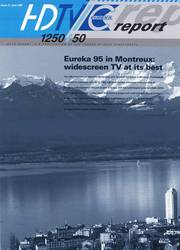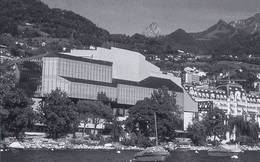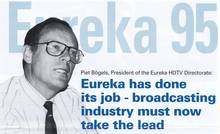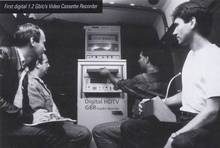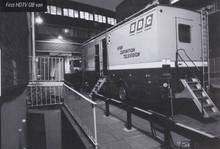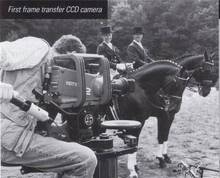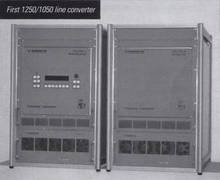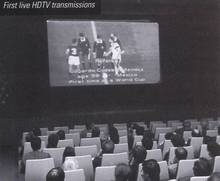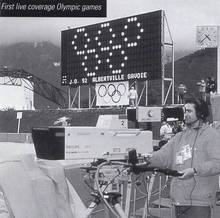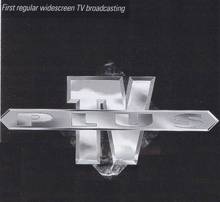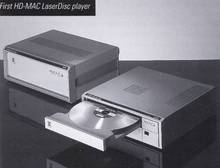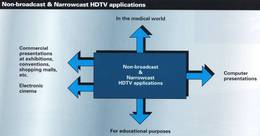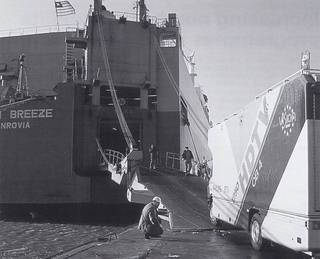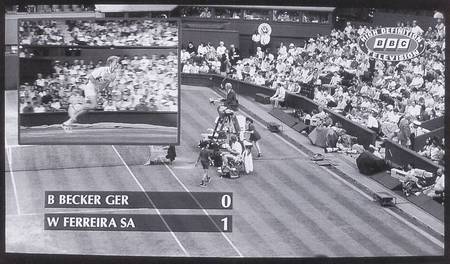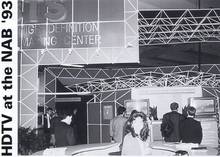Der Eureka Report - issue 11 - Juni 1993
Wenn alle Informationen stimmen, war das das letzte "Internationale Television Symposium mit technischer Ausstellung" in Montreux mit dem wunderschönen Ambiente am Genfer See mitten zwischen den hohen Bergen und natürlich der illustren Gesellschaft.
"Dabeisein" war damals alles, vor allem für die Fernsehkollegen aus dem Osten Europas. War es doch für gehobene Techniker und Fernseh-Entscheider die einzige Möglichkeit, dem Sozialismus für ein paar Tage legal zu "entfleuchen". Doch das war nach 1989 vorbei. Jetzt durfte Jeder in den Westen, wenn er nur genügend Geld hatte.
Montreux war nicht nur zu eng geworden (nicht ausbaufähig), ja, es hatte seinen Sinn verloren. Auch Eureka 95 verabschiedete sich ab 1993 so langsam, aber nicht wegen der Öffnung des Ostens. Die (technischen) Felle schwammen davon. Der Transport des HDTV Bildes zum Zuschauer ins Wohnzimmer war immer noch nicht zufriedenstellend "für alle gelöst", die 16:9 Röhrenfernseher waren viel zu klobig, zu schwer und viel zu teuer und dann manchte die Digitaltechnik Riesen-Fortschritte.
.
Eureka 95 auf dem "International Television Symposium" in Montreux: "widescreen TV at its best"
The 18th International Television Symposium and Technical Exhibition in Montreux/Switzerland, which will be held from June 10-15,1993, will mark another milestone in the planning of Europe's most successful research project. It is clear that the technological progress made within the Eureka95 project in a rather short time frame is unique and could only be realized thanks to an excellent cooperation of over 60 european organisations.
The large scale pilot transmissions of 1992 that were planned to test the complete chain of HDTV equipment under operational circumstances have exactly supplied the information needed to finetune the system. The finetuning has now been done and a few improvements have been incorporated. The final result is a very good system as will be shown to those visiting the stand.
.
In a small (video or movie) theatre a selection of European HDTV productions will be projected on a large screen by front projectors, fed by an HD-MAC signal received from satellite. The signal will be encoded and decoded with second generation hardware, containing improvements such as MCCI Plus (Motion Compensated Compatibility Improvement), TCI Plus (Temporal Compatibility Improvement), DATV (Digitally Assisted TV) and E7E (Enhanced E7 Preemphasis). The same signal will also be fed to new professional HDTV monitors elsewhere in the stand.
The most striking improvement is probably the excellent quality of the compatible picture in D2-MAC which can be seen on tube displays of various sizes produced by the consumer electronics manufacturers participating in the project.
HD-MAC is a flexible system. It could be readily adapted to a need from broadcasters to make a more efficient use of available satellite channels by transmitting more programmes in one channel. Visitors to the stand will see "MultiMAC" demonstrated on a large 56" display, showing four different programmes on four quadrants of the screen. Next to this display four regular D2-MAC receivers will each show one of the four programmes.
Last but not least, visitors are shown 1250/50 line HDTV studio quality pictures, sourced from a studio VTR as well as from a still picture store. The joint Eureka 95 / Vision 1250 stand (P871) is located in the pavilion of Technology of the Future, opposite the Grand Palace Hotel in Montreux. The Technical Exhibition will be open from 10 a.m. to 6 p.m. from Friday, June 11 through Tuesday, June 15, 1993.
Montreux '93 - The Broadcasters Resource
Never was there a greater need to capsulate the advances made, to demonstrate the new equipment available, or to identify the prospects for improved and new services to be provided by broadcasting and cable. The Montreux '93 programme will do exactly this.
The first Montreux International Television Symposium was held 35 years ago. Since that first time, Montreux has become renowned for providing a technical programme, appealing not only to engineers and technical experts, but also to the decisionmakers of the broadcasting and cable industry.
The 1993 programme will again concentrate on the cutting edge of technology applied to traditional television broadcasting and cable operations. In addition, it will also serve the interests of the creative community in terms of new tools for their artistry and new outlets for their work. The Weekend Forum (June 11-12 1993) will present the status and prospects for High Definition in cinema production, multi-media television programming, creative potential of High Definition and the economic strategies to be pursued.
During Future Technology Day (June 14), experts in various fields will outline the new services which emerging technology will make possible. In addition, the International Electronic Cinema Festival will run concurrently with the Symposium, presenting programmes, the artistic achievements of which were made possible by digital technology and HDTV programme production. Members of Vision 1250 will show programmes shot in 1250/50 HDTV quality.
.
Another milestone for Eureka 95 HDTV project
"HD-MAC transmission standard submitted for final acceptance"
The Eureka 95 HDTV project passed a milestone when it officially handed over the draft specification of the HD-MAC transmission standard to ETSI/EBU. ETSI, the standardisation body designated by the EC to establish the final standard will circulate the draft for public enquiry. It is expected that the procedure will be finalized in the beginning of 1994.
Meanwhile EBU has started another round of tests of the HD-MAC chain which now incorporates a number of improvements based on the feed-back information gained during the experimental broadcasts of the Olympic Games in 1992.
From a technical point of view the complete chain from camera to receiver is now ready for introduction. The actual state of the system will be demonstrated at the 18th International Television Symposium and Technical Exhibition in Montreux from June 11-15 1993.
"Germans" ??? enthusiastic about HDTV
Films are best to be seen in HDTV, HDTV receivers should not be wider than 1 meter, and yes, HDTV will persevere. Last year in 1992, the German leading video magazine "Video" conducted a study amongst its readers, who were asked to answer a questionnaire regarding HDTV after they had watched HDTV broadcasts of the Olympic Games.
Readers were asked how they feel about HDTV, if they believe that HDTV has a future and what kind of television equipment they would like to have to watch HDTV programmes.
Asked about their impression of HDTV, 83% of the readers said they were enthusiastic about HDTV, 10% was disappointed and 5% didn't care one way or the other. By far the most people (90%) believe that HDTV will persevere and be successful in the near future. Only 10% thinks this will not be the case.
In terms of quality, 81% of the readers thinks D2-MAC transmissions are better than PAL transmissions. 19% chooses for PAL quality. Consumers are not interested in projection tv's with gigantic dimensions. The majority (75%) prefers to have a television set with a screenwidth of up to 1 metre; 21% is willing to have a screen up to 2 metres and only 3% would choose a screen larger than 2 metres. The most preferred HDTV programmes to watch are films (84%), followed by sports (39%), music programmes (33%), and shows (24%).
Pieter Boegels, President of the Eureka HDTV Directorate:
Eureka 95 has done its job . . . .
broadcasting industry must now take the lead !
"Technically speaking, the existing HDTV technology, as developed within the Eureka 95 project, is extremely successful. Now we must throw the ball to the broadcasters and transmission authorities. They have shown their willingness to pick it up, but it does require large investments and when subsidies fail to come in, this could be a reason to reconsider."
Pieter Bogels, President of the Eureka HDTV Directorate, is clearly in two minds about the subject of HDTV. The obviously successful activities of Eureka 95 are threatening to considerably slow down now subsidies for the broadcasters and programme providers are dwindling. He is therefore very pleased with the initiatives of broadcasters such as BBC and RAI to carry on with their activities in the field of HDTV programme production.
"It shows that they have faith in the system, and rightly so", he says. "We have gone through a deep valley, these last few months", Bogels continues. "The power of public broadcasters is decreasing, which means a demise in technical support of HDTV. In addition, Europe has not been able to decide on subsidies. Yet, everyone assumed that they would be made available. The participating broadcasters had plans to replace their current equipment with HDTV equipment, but their plans were based on funds they would receive from the EC."
The European HDTV system, developed within the Eureka HDTV project EU 95 is a complete end-to-end 1250 line 50 Hz standard providing standards, systems and equipment for the studio/production, transmission, reception and replay areas.
According to Pieter Bogels, it is one of the most successful high technology projects ever undertaken. It has succeeded in catapulting the European electronics and broadcasting industries into a leadership position in only six years. But, he says, a project is only really successful when the commercial implementation in the marketplace is also a success.
The EU 95 project started in 1986 with the mission of defining the technical specifications for a new HDTV system for the 1990s and beyond. The more
than 80 participants from 13 countries have now developed, field-tested and implemented a complete HDTV system and, in addition, developed facilities for conversion to existing and potential TV standards anywhere in the world.
"Since the start of the project, many changes have taken place. For example, HD-MAC was originally designed for use on high power Direct Broadcast Satellites (DBS). However, these have been overtaken in popularity by the medium power Fixed Service Satellites (FSS). To handle this development, the HD-MAC pre-emphasis has been adjusted to ensure optimum performance on both DBS and FSS satellites. Tube camera's are replaced by very sensitive CCD camera's. Analogue recorders will be succeeded by digital recorders on short notice. Prototype full digital HD-studios have been demonstrated."
According to Pieter Bogels, the first thing most associate the Eureka project with, is HD-MAC. "But HD-MAC takes up only 15% of our research efforts. HD-MAC is thus a small part of the total Eureka effort. Eleven project groups each have their own
detailed workloads and deal with subjects such as studio equipment, HDTV receivers, decoders, carriers such as VCR's and LaserDisc players, and their components such as picture tubes, lasers, heads, tape, bit rate reduction systems for contribution links, and the compatible audio 5-channel surround sound aspects in connection with HD transmission."
The Project Group 12 is also worth mentioning. This project group is involved in the non-broadcast and narrowcast applications of HDTV: the distribution of images not directed to the general public and distributed via ways other than the conventional transmission and cable networks used for broadcast television. Good examples are HDTV multimedia systems which includes an HDTV interactive video system using CD-ROM and Photo-CD, and large screen projection systems for educational purposes, videoconferencing, or information distribution for large, specific audiences.
"Development has proceeded at a rapid pace and progress has been demonstrated annually at key international events", Boegels says. The IFA in Berlin in 1991 saw the first-ever live broadcasting of HD-MAC programmes as part of normal public broadcasting. Using 1250/50 OB vans and equipment from Vision 1250, an Economic Interest Grouping, live HDTV programmes were produced by the German public broadcasters ZDF and ARD. These were integrated into the programmes of "Eins Plus" and "3SAT" and transmitted in place of the normal D2-MAC signals. Viewers with conventional sets at home were unaware of the changes as broadcasters switched from one system to another. This was a crucial demonstration of the ability to provide a compatible end-to-end 1250-line HDTV service from the studio floor to the viewer's living room."
The Eureka project has now entered phase III, which will run well into 1994. Further research and development will be utilised to incorporate the feedback from field-tests, finetune the standards and create or improve hardware prototypes both for studio and domestic hardware.
"But the fact remains the same: we have a stalemate in a non-united, turbulent Europe. Every country has its own financial problems. And the public broadcasters, once so powerful, are increasingly losing their territory to the fast growing private broadcasters. Once the turbulence has passed, Europe shall, and hopefully will, decide on its own destiny in TV/HDTV broadcasting."
.
During 1992, EUREKA 95 and Vision 1250 combined forces to test the HDTV system and equipment under real-life conditions through HDTV coverage of major events such as the Winter Olympics in Albertville, the Summer Olympics in Barcelona, and the Wimbledon tennis championships in London.
Test broadcasting is continuing on TV-SAT at a current level of four hours per day. Forty-two organizations from 16 countries are participating in Vision 1250, which was set up as a sister organization to Eureka. Its goal is clear and simple: to facilitate programme production by making available HDTV equipment, support and training. To date, close to 1.000 hours of HDTV programming has been produced with the assistance of Vision 1250.
.
"Eureka 95 played a significant role in another development, namely the formation of national HDTV Platforms. In April 1989 the European Board of Ministers decided to support the industry with its development and promotion of the European HDTV standard and advised that, because of the far-reaching economic, social, political and cultural implications, all parties cooperate to implement HDTV."
Pieter Boegels regrets that the directives, as formulated at the start of the project, did not have a watertight formula with regards to transmission standards.
"In an ideal situation, every European country should adopt the directives as a law. However, this has not happened because they left room for interpretation. Furthermore, the industry did not deliver the requested products in time. At the same time, drastic changes in broadcasting took place. The current directives do not talk about standards any longer, so we are even further from reaching a common European standard."
The industry is also unsure about the direction in which to head. Boegels foresees a current of different standards cascading over the continent. "I believe this may cause a stalemate. After all, professional users urgently need standards to facilitate exchange of images and data in line with the transmission standard. The same goes for the consumers, they won't know what equipment to buy and probably decide to postpone purchasing new television sets."
Pieter Boegels believes that the new broadcasting industry will attack the market in an increasingly aggressive manner. "In an effort to gain a monopolistic position, the industry will develop their propriety systems with propriety scrambling systems and decoder boxes. The situation gets more complex as we speak and unfortunately we haven't taken any legal measures to prevent it from happening. There is a clear need for a single system - whatever the choice may be - in a single Europe."
If there is no political or economic unity, says Bogels, achieving a technological unity is almost impossible."
So what will the future bring?
"Although we have - in principle - a winner with our HDTV system, it will not reach the finish line as long as we are not heading in the same direction. Total agreement exists on one key issue: the importance and attractiveness of widescreen 16:9 TV broadcasting. The hardware is available and it will at least get us moving. It is a small step, but it will cause people to require a better picture quality. That, in turn, will take us to HDTV after all."
In attaining their leadership position in HDTV, EU 95 participants have scored several notable 'firsts', including:
.
- World's first prototype digital 1.2 Gbit/s Video Cassette Recorder
- World's first HDTV OB van
- World's largest operational HDTV OB van fleet
- World's first frame transfer CCD camera and slomo VTR
- World's first 1250/1050 line converter
- World's first live HDTV transmissions in regular programmes via satellite and hyperband cable network
- First-ever complete live coverage of the Olympic Games
- World's first regular widescreen (16:9 format) TV broadcasting (3 to 4 years ahead of the rest of the world)
- First affordable 16:9 receivers (D2-MAC)
- First HD-MAC LaserDisc player and HD-MAC VCR.
.
Increasing demand for narrowcast and non-broadcast HDTV applications
It appears that those who predicted that non-broadcast applications could provide an early growth area for the use of HDTV could well be proved correct. Application led activities are putting pressure on the members of the Eureka's project group for non-broadcast applications to provide workable solutions for practical problems in many fields. Not least is the pressure to provide equipment in significant quantities for exploitation once pilot studies have demonstrated feasibility.
DIANA - Still Image Scanning
A high resolution scanner based on a 6.000 pixel CCD line scan device has been incorporated by Thomson Broadcast into DIANA, a system for the archiving and distribution of digital images. DIANA allows image capture at resolutions adapted to various needs and the conversion between HDTV and computer formats for the transmissions and manipulation of images. It also provides tools for the creation, manipulation and storage of images using compression to reduce the memory and network bandwidth required. The associated workstation UNIX, based and operated under X11. The images can be displayed in HDTV or standard computer format.
A prototype system has been delivered to the Louvre museum in Paris, where it is in use as a system tool in, for example, the examination of X-ray images of paintings.
The CD-ROM has already become an important medium for the publication of text and data. CD-Photo offers unequalled possibilities for the publication of (better than) HDTV quality images. Philips has produced a number of prototypes of hardware and software able to read CD-Photo images and display them in HDTV. This offers a significant improvement in the support provided to pathology laboratories and others needed to compare the detailed structure of samples with standard images.
The publication of standard images as CD-Photo discs for use in the identification of childhood cancer is in study by a UK university based group and a major international publisher. HDTV assisted microscopy will use the CCD element of an HDTV camera to provide the laboratory personnel with the best possible real time images in research and diagnostic work and support the use of CD-Photo based comparison material.
To take advantage of the opportunities offered for the use of HDTV still images in simulations, presentations and product promotions, etc. Philips CE has produced an HDTV presentation system which allows the presentation of a rapid sequence of images. A variety of image sources can be used, including CD-Photo and computer generated graphics. Under the control of a PC, a selection of images is stored in RAM and accessed in a programmed way or at random. The facilities for a full multimedia presentation with pre-recorded audio are included.
HDTV MULTIMEDIA
HDTV video based multimedia is receiving serious attention for training purposes. VideoLogic has produced a prototype expansion board for 386/486 based PC's to integrate recorded HDTV and computer generated graphics and display the result on an HDTV monitor. In a typical application the computer would monitor the progress of the student through the training programme and control the operation of the HDTV source, such as an HDTV Laserdisc player. "Seleco" is working on a complete environment for the integration of de-interlaced HDTV with graphics for display, along with upconverted standard definition sources and interlaced HDTV on series of display devices, including an LCD projector.
The use of HDTV in entertainment and public information systems is also receiving attention. Using a combination of Laserdisc programming and realistic sound and lighting, the Dutch National Maritime Museum in Amsterdam is planning a special exhibit to illustrate the history of the Dutch East India Company.
HDTV NETWORKING
The installation of the 1992 Olympic Receiver sites in corporate and public locations was, for most site operators, a temporary matter. It has become clear that a number of groups are ready to make use of a network of professional HDTV sites for the reception of narrowcast programming. Philips is working in a cooperative venture to set up such a network in the summer of 1993, based on medical centres of excellence, for use in a Europe-wide health improvement campaign. Other uses include semi-interactive training and product promotion. Basic studies on system parameters of HDTV video conferencing is being carried out by the Deutsche Bundespost in Darmstadt.
HDTV SURGICAL
HDTV offers the opportunity for improving the direct support to the surgeon in procedures where a microscope or laparoscope is currently used. The BTS CCD camera is the key to these applications which can also make use of the HDTV network for consultation and training.
LARGE SCREEN DISPLAY SYSTEMS
Members of the project group continue to improve displays. Barco and Thomson have new 70" and 55" rear projectors while split screen specialists Vidiwall and ViDiSys have further refined their products. There is interest in the use of large HDTV projectors for environmental simulation in the training of civilian and military pilots, drivers and operatives. LaserCreations and SESO are the project group leaders in this area, while Gretag and Seleco continue to work on their products for the highest quality screening of HDTV material.
Media Investment Club stimulates HDTV activities
The "Media Investment Club", headquartered in Bry-sur-Marne, France, is inviting audio-visual producers, authors and directors as well as European television channel programme directors to present projects for the production of programmes in European standard high definition video, intended for commercial distribution. The Club takes an active part in the integration of new techniques in audiovisual production and distribution projects, amongst others by funding and co-producing HDTV programmes. To date, well over 25 HDTV productions have been supported.
The Media Investment Club was set up at the initiative of the MEDIA Programme and the EC, with the aim of supporting innovative and creative projects intended for the European market. Other founder members include the Institut National de TAudiovisuel, France 2, France 3, BBC TV, Canal Plus, Little Big One, the NOB (Nederlands Omroep-produktie Bedrijf NV), Pesa Electronics SA, Philips International BV and Thomson Broadcast/TCE. The Club has centred its activities around the creation and production of audio-visual programmes, the training of designers and professionals in advanced technology, the transfer of know-how among industrial enterprises, research institutes and production companies, and the distribution of programmes both within and outside the EC. countries. Its activities focus on three kinds of media: CD, Digital, and HD media.
The Club gives financial support in the form of co-production contracts with a return on investment, or in an allocation of subsidies to training programmes. Support may also come in the form of technical and financial advice on projects supported in coordination with other constituent organizations of the MEDIA-programme. The 1993 budget of the Club consists of 6.2 million Ecus.
Organizations interested in support from the Media Investment Club must keep in mind that projects should correspond to the objectives of the Club. They must obtain the patronage of two members of different nationality. Projects may be then presented in a presentation dossier, which includes a detailed synopsis, technical description, estimate of production costs, financial plan, implementation plan and distribution plan. The decision to take on a project is taken by the Board of Directors on the advice of the Evaluation Committee.
The next deadline for submission of HD-projects is October 1, 1993. The submitted programmes may deal with any informative, educational or entertaining subject where the use of High Definition television lends itself to a new way of treating the subject. Fiction and creative documentary programmes, except for live coverage of major events, with a view to short-term exploitation, are of top priority.
Increasing number of satellite programmes in D2-MAC
Throughout Europe, an impressive number of satellite programmes are being broadcast daily in D2-MAC or D-MAC. As many as ten stations broadcast over 20 hours per day.
Well over half of them are accessible only via Eurocrypt-M or Eurocrypt-S. In 1992, the French broadcaster Canal Plus had 35.000 D2-MAC subscribers, while the Scandinavian broadcasters TV 1000 and FilmNet counted 660.000 subscribers.
The research and technology centre of the German Post recently decided to continue its HD-MAC test transmissions throughout 1993. The transmissions are broadcast daily between 9.00 and 13.00 hours in the 16:9 format.
Following is a current listing of the programmes in D2-MAC or D-MAC. They can be viewed by everyone in possession of a satellite dish and a D2-MAC receiver.
Eine gekürzte Übersicht der Satelliten (um 1993)
| Satellite | Orbit | Frequ. | pol | Programm | Standard | hours/day |
| (*E) | (GHz) | |||||
| Intelsat6-F1 | 0.0 | 10.995 | V | BBC TV | D2-MAC | 24 |
| TV Sat 2 | -19.2 | 11.747 | L | RTL | D2-MAC | 20 |
| TV Sat 2 | -19.2 | 11.823 | L | Sat 1 | D2-MAC | 19 |
| TV Sat 2 | -19.2 | 11.900 | L | 3SAR | D2-MAC | 10 |
| TV Sat 2 | -19.2 | 12.054 | L | Eins Plus | D2-MAC | 4 |
| TDF 1A+2A | -19.0 | 11.727 | R | MCM | D2-MAC | 24 |
| TDF 1A+2A | -19.0 | 11.804 | R | Canal Plus | D2-MAC | 22 |
| TDF 1A+2A | -19.0 | 11.881 | R | Arte | D2-MAC | 5 |
| TDF 1A+2A | -19.0 | 12.034 | R | France 2 16x9 | D2-MAC | 18 |
| Olympus 1 | -18.8 | 12.169 | L | D2MAC | D2-MAC | 4 |
| Intelsat 5 | -18.0 | 11.541 | H | Norsk TV2 | D2-MAC | 6 |
| Telecom 2A | -8.0 | 12.522 | V | Canal Plus 16x9 | D2-MAC | 22 |
| Telecom 2A | -8.0 | 12.564 | V | Cine-Cinefil 4x3 | D2-MAC | |
| Telecom 2A | -8.0 | 12.606 | V | France 216x9 | D2-MAC | 18 |
| Telecom 2A | -8.0 | 12.690 | V | Cine-Cinemas 16x9 | D2-MAC | |
| Telecom 2B | -5.0 | 12.585 | H | D2-MAC | ||
| Telecom 2BA | -5.0 | 12.669 | H | Cine-Cinemas 4x3 | D2-MAC | |
| Intelsat 5A-F12 | -1.0 | 11.133 | H | TV4 Norge | D2-MAC | |
| Tele-X | 5.0 | 12.673 | L | FilmNet The Movie | D2-MAC | 24 |
| Eutelsat 2-F1 | 13.0 | 11.055 | H | Kabelkanal | D2-MAC | 24 |
| Eutelsat2-F1 | 13.0 | 12.563 | H | Europace | D2-MAC | 4 |
| Eutelsat 2-F3 | 16.0 | 10.987 | H | EuroStep | D2-MAC | 4 |
| Eutelsat 2-F3 | 16.0 | 11.678 | H | TV Plus 16x9 | D2-MAC | 3 |
| Astra 1A | 19.2 | 11.244 | H | TV3 Sverge | D2-MAC | 8 |
| Astra 1A | 19.2 | 11.303 | H | TV1000 | D2-MAC | 7 |
| Astra 1A | 19.2 | 11.362 | H | FilmNet Plus (Scan) | D2-MAC24 | |
| Astra 1B | 19.2 | 11.612 | H | TV3 Denmark | D2-MAC | 8 |
| Astra 1B | 19.2 | 11.671 | H | TV3 Norge | D2-MAC | |
| Intelsat 5-F15 | -18.0 | 11.133 | H | SVT1 | D-MAC | 7 |
| Intelsat 5-F15 | -18.0 | 11.176 | H | SVT2 | D-MAC | 7 |
| Intelsat 5-F12 | -1.0 | 11.177 | H | SVT2 | D-MAC | 7 |
| Intelsat 5-F12 | -1.0 | 11.681 | H | SVT1 | D-MAC | 7 |
| Thor | -0.8 | 11.785 | R | CNN International | D-MAC | 24 |
| Thor | -0.8 | 11.861 | R | 2 | D-MAC | - |
| Thor | -0.8 | 11.938 | R | 3 | D-MAC | - |
| Thor | -0.8 | 12.012 | R | FilmNet: The Movie | D-MAC | 24 |
| Thor | -0.8 | 12.092 | R | 5 | D-MAC | |
| TeleX | 5.0 | 12.322 | L | NRK | D-MAC | 9 |
Warner Brothers and BTS conduct major electronic film production test
In an effort to test whether the marriage between HD images, film, and world TV standards is successful, BTS' HDTV equipment has been used at the American Warner Brothers Studios. The experiment in electronic film production may help shape the future of Hollywood motion pictures and television production.
The studio is testing the commercial viability of 1250-line high definition (HD) imaging as a format for origination and mastering to 35mm film, as well as mastering format to facilitate subsequent down-conversion to NTSC, PAL, and future widescreen video formats.
A fully equipped 11ton production van, equipped with a full array of CCD video cameras, video recorders, switchers and other production equipment, was shipped from Germany to the Warner Bros. Studios in Burbank, California for a five-week experiment.
Anmerkung : Und damit war die Darmstädter KCH 1000 schon out, endgültig raus aus dem Rennen. Ein "Dank" geht nach Breda. So hatten sich die Entwickler in Darmstadt die Zusammenarbeit mit dem neuen 50% Eigentümer Philips nicht vorgestellt.
Cinematographers and studio technical personnel used the equipment, and with the help of a BTS support team, a selection of realistic production situations was recorded. They also conducted experiments in shooting simultaneously both standard 4:3 TV screen and widescreen 16:9 aspect ratios.
Warner Bros. and BTS have enjoyed a long association through the studio's use of LDK-9 and LDK-91 CCD video cameras on popular U.S. programmes such as "Night Court" and "Growing Pains". The BTS cameras have earned the studio's respect because of their ability to produce film-like images. This is due both to their mature colorimetry capabilities, and to the frame-transfer CCD sensor
technology which totally eliminates smear.
The LDK-9000 CCD cameras, which were used for the experiment, utilize improved versions of both technologies. Technicians also discovered during the tests that the LDK-9000 demonstrated a dynamic range similar to Eastman Kodak's popular 5293 35mm film stock: 200 ASA. This film is used on many filmed episodic network and syndicated TV series. According to Dick Crippa, BTS Corporate Senior Vice President, BTS is uniquely suited to support the Warner Bros. Experiment. "We are one of only two companies in the world with a full line of high-definition imaging equipment", Crippa said. "We are also the only company with a full bandwidth HD digital disk recorder: a major key to successful tape-to-film transfers of 1250/50 images."
BACKGROUND
Electronic film production has long been the subject of intense scrutiny in Hollywood, but has yielded few viable results. It offers the possibility of recording video images that capture the subtleties and nuance of celluloid film production, yet are produced with the speed, convenience and flexibility of video. Unfortunately, few if any experiments in this area have proven to be commercially viable.
The Warner Brothers-BTS experiment differs in several respects from its predecessors. A key element is whether 1250 imaging (1250-line/50-field/2 to 1 interlaced) can be an acceptable alternative to film as a source for Warner Brothers studio archives. Successful archiving is a "must" for studios, whose fortunes rest in no small part on their ability to use and re-use the contents of their vast motion picture and television libraries. Warner Bros. archives its productions on film because it is the only high-resolution recording medium that is seemingly immune to changing technology.
Anmerkung aus 2013: Das stimmt aber so nicht, denn die ganzen Farbfilme (mit wenigen Ausnahmen) verändern ganz gewaltig die Farben bzw. verlieren sie.
Part of that success is the format itself: 1250/50 video is uniquely suited for electronic film production because of its high (1250) lines of TV resolution, and because its 50 fields/25 frame per second transfers easily to film's 24 (U.S.) or 25 (Europe) frame rate.
In transferring 1250/50 video to film, BTS' HDDR-8000 high-definition digital disk recorder is a key device. HD video-to-film transfers must be done frame by frame (in non-real time) because of its memory-intensive nature. The HDDR's ability to hold a full frame of high-definition RGB video in full-bandwidth digital storage is ideal for clean transfers.
A variety of production situations were employed to test the commercial viability of the format. They included exterior footage, a motion control sequence, makeup tests, and a multi-camera shoot. For the Warner Bros. project, 1250/50 tape-to-film transfers were completed at Cinema-L in Vienna.
In addition to archiving, the studio is concerned about protecting new productions for future wide-screen distribution. Film origination remains the best source to date. However, with the aid of a new generation of standards converters, built by companies such as Thomson-CSF-LER and Snell & Willcox, 1250/50 video is also converted easily to other video formats because it has the highest number of horizontal scan lines of any existing or proposed HDTV standard.
From the project group...
Transmissions
In the past 15 months the project group Transmissions has transmitted programmes via TVS AT. More transmissions are planned using the new encoder (and algorithm) in order to test transmission equipment in an operational environment, to provide a continuous HD-MAC presence and to promote widescreen in general. It is expected that the improved compatibility will allow good reception by D2-MAC sets.
Two types of transmissions are envisages, namely those of various software, in a 'dead' period on a satellite or on transponders that are not in regular use; and those that are associated with a regular broadcaster en possibly interlaced in a D2-MAC transmission. An agreement has been made that test transmissions will take place on Hispasat with the help of Retevision. Other satellites that are considered for these transmissions are TVSAT, Telecom 2A/B, TDF, Eutelsat (with TV Plus and other operators).
Current test transmissions include HD-MAC programmes (09.00 to 13.45 hrs, every day except Sunday) on TVSAT's Eins Plus channel, D2-MAC 16:9 (four hours each day) on TV Plus via Eutelsat III, and intermittent HD-MAC transmissions on Telecom 2A/B by France Telecom.
High definition television for programme makers
Brendan Slamin in his book "High Definition Television for Programme Makers", has attempted to redress the balance by producing a work specifically aimed at broadcasters and programme makers.
The book, which has 132 pages, is attractively produced with a large number of diagrams and excellent colour photographs. It is certainly an excellent starting point for all television programme makers who are thinking of moving into the field of HDTV. It is also likely to be of interest to technicians and engineers who would like to learn more about HDTV.
"HDTV for Programme Makers" by Brendan Slamin is published by BBC Television Training. It is available for £ 17.50 (plus £ 1.50 postage and packing) from BBC Television Training, BBC Elstree, Clarendon Road, Borehamwood, Herts, WD6 1JF, UK.
Brendan Slamin held a number of senior management posts in the BBC, including Chief Engineer for the Regions, Head of TV O.B. operations and engineering and Project Director of the 1986 Edinburgh Commonwealth Games before becoming involved in the world of high definition. This enabled him to bring a wide experience of programme making requirements to the research programmes which were underway.
He led two projects in the massive Eureka 95 research programme which brought European HDTV to the fore and commissioned the first BBC HDTV programmes in 1987. He received the special "Judges award" of the "Royal Television Society" for his part in this work. In addition to his activities in the UK, he has undertaken much HDTV work in other European countries as a member of the Eureka 95 team.
.
First ever cinema film in HD 1250/50
For the first time, HD 1250/50 has been used to edit a short cinema film. 'Firiety - The Movie' is a pyroanimation-clip made by Gerrit van Dijk in cooperation with the Dutch HDTV Platform.
'Tiriety-The Movie' illuminates the relationship between man and fire in a satirical manner by means of spectacular fireworks and film fragments, with a wink at film genres in which fire plays a role both literally and symbolically. 'Firiety - The Movie' ends a la Disney's 'Fantasia' where the sun as the inexhaustible source of energy feeds the creative fire.
Translated into film: every generation develops new techniques and - dependent on this - new film genres. The visual image of fire and creativity continues to change, but there is always the
grand outcome: the experience at the cinema.
The filmmakers intended to integrate a number of images into one composition, guided by a piece of music. Since the existing editing techniques were not adequate to realize the project, the Dutch HDTV Platform assisted in the development of a unique process to edit the original 35mm film via HD-tape. After transferring the 35mm material to HD 1250/50 tapes, the tapes were edited at the NOB, utilising the four quadrant method, and the edited version was then transferred back to 35mm film.
The pilot-project was successful and proves that digitizing 35mm film for editing purposes offers endless possibilities that were previously unknown.
HDTV at the NAB '95
1250 High Definition was again much in evidence at NAB where this year BTS and Thomson waved the flag for the European system. The HDTV World Exhibition area was dominated by the BTS stand, on which there was a Vision 1250/EX Camera OB unit which was open for all to see. It demonstrated the advanced state of European HDTV and showed its readiness for production.
WARNER BROTHERS
This was reinforced by the fact that the OB-unit had been to Warner Brothers studios where tests had been undertaken to assess the 1250 standard for the production of films for cinema and television. Warner had set up a number of different scenes which would test the characteristics of 1250 HDTV after transfer to 35mm film. In particular they looked at spacial and temporal resolution, gamma, grey scale, colorimetry and "the film look", all of which are so important to producers wanting a top quality product.
Included in the tests were a chase scene on an outside lot and a situation comedy scene shot multi-camera in a studio. Both of which enabled problems of shooting for two different aspect ratios (16:9 and 4:3) to be examined.
Some of the early results of these tests were demonstrated by Steve Reagan, who had been in charge of the tests for Warner, in the HDTV theatre on the stand. It was a continuation of the theme of "Bridging Three Worlds", demonstrated by Eureka 95 and Vision 1250 at a number of shows in 1992.
Whereas on these previous occasions the film-to-video transfer had been from Kodak Super 16mm test film, this time all the material had actually been shot in Hollywood, either as 1250 video or as 35mm film. The video was transferred to 35mm film at "Cinema L" in Vienna.
The demonstration included some of the scenes shown as 1250 video from a Seleco projector and, from a 35mm projector, video transferred to 35mm film and the same scenes shot with a 35mm camera. Warner and delegates alike expressed their delight at the quality of the resulting pictures and forecast a big future for 1250 HD video in the production of motion pictures.
Also displayed on the BTS stand were the award winning Thomson 1250/50 to 1050/59.94 digital standards converter and the Snell and Willcox 1250/50 to 525/59.94 converter.
Both units were able to impress the many visitors to the stand with the quality of the display and reinforce the ability of 1250 HDTV to enter the U.S. market.
Thomson also exhibited 1250 HDTV on their own stand where an HD-Light camera was prominently displayed.
A major interest at the HDTV World Conference and Exhibition was the progress being made towards the choice of a digital transmission standard for the U.S.A. The four competing companies all had demonstrations in the exhibition where they were able to show the latest and explain the advantages of their particular proposal. In the context of an exhibition there seemed very little to choose between them.
In the conference it was confirmed by the ATSC that each system tested had shown advantages and disadvantages, no one was clearly superior to the others. Much pressure is being applied to encourage the four to create "The Grand Alliance" which would have the objective of producing a single proposal combining the best features of each. Time will tell if this comes to pass, but in any case the revised timescale for announcing the winning system is put at the end of 1993.
EUROPEAN VIEW
Not all the work on digital systems is being done in the U.S.A. and the opportunity was given for delegates to be told about the European advances. As was the case in 1992, NAB had once again invited the EBU to present the European view of HDTV.
Colophon
HDTV Report is a publication of the Eureka 95 HDTV Directorate
Editorial Staff: EU95 Communications Committee
Production and design; Smulders Corporate & Marketing Communications B.V., the Netherlands
Information: Eureka 95 Communications Committee,
P.O. Box 523, NL 5600 AM Eindhoven, The Netherlands,
© Eureka 95,1993

